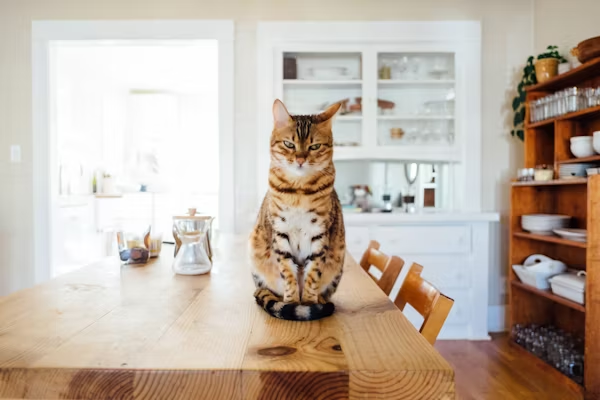Having a dog or cat that gets anxious or aggressive around visitors can be challenging for pet owners. Whether your pet hides, barks, growls, or shows signs of stress when guests arrive, it can create uncomfortable situations for everyone. Understanding why your pet reacts this way and how to help them overcome their fears is essential to creating a more peaceful home.
In this guide, we will explore why dogs and cats may dislike visitors and provide practical steps you can take to ease their anxiety and help them feel more comfortable when guests come over.
Understanding Why Your Pet Doesn’t Like Visitors
1. Fear and Anxiety
- New faces and smells: Dogs and cats rely heavily on their senses of smell and familiarity. When new people enter their environment, it disrupts their sense of comfort.
- Lack of socialization: Pets that haven’t been exposed to many different people during their formative months may develop anxiety when encountering strangers later in life.
2. Territorial Behavior
- Protecting their space: Both dogs and cats can be territorial. When a stranger enters their home, they may feel threatened and act defensively to protect their environment.
- Guarding their owner: Pets may see their owner as part of their “pack” and feel the need to protect them from perceived threats, like visitors.
3. Past Negative Experiences
- Trauma or mistreatment: If your dog or cat has had a negative experience with strangers in the past, they might associate visitors with fear or pain.
- Overstimulation: Some pets are sensitive to loud noises or sudden movements, which can make them uneasy when guests are present.
4. Medical Issues
- Pain or discomfort: Pets dealing with underlying medical issues, such as joint pain or dental problems, may be more irritable and prone to reacting negatively when approached by strangers.
How to Help Your Dog or Cat Feel Comfortable with Visitors
1. Create a Safe Space for Your Pet
For Dogs:
- Designate a quiet room: Set aside a room in the house where your dog can retreat to when guests arrive. Make sure it’s filled with familiar objects, like their bed, toys, and water.
- Use calming aids: Consider using pheromone diffusers, calming collars, or natural supplements designed to reduce stress in dogs.
For Cats:
- Offer hiding spots: Cats often prefer to hide when they feel stressed. Provide cozy areas like cat trees, covered beds, or even open closets where your cat can go when they need a break.
- Provide vertical space: Cats feel safer when they can observe from a distance. Adding cat shelves or tall furniture for them to climb can help ease their anxiety around visitors.
2. Gradual Desensitization to Visitors
For Dogs:
- Controlled introductions: Begin by having visitors stay at a distance where your dog feels comfortable. Over time, gradually reduce the distance, always rewarding calm behavior with treats or praise.
- Use a leash: Keep your dog on a leash during initial introductions to help you maintain control and reassure them that they’re safe.
For Cats:
- Allow observation from afar: Don’t force your cat to greet visitors. Instead, let them observe from a distance, where they feel safe. Over time, they may grow more comfortable and approach on their own terms.
- Reward calm behavior: Use treats or affection to reward your cat when they stay calm in the presence of guests.
3. Positive Association Training
For Dogs:
- Offer high-value treats: Each time a visitor arrives, immediately offer your dog their favorite treats. Over time, they’ll start associating guests with positive experiences.
- Playtime before guests arrive: Tire your dog out with physical activity before guests come over. A well-exercised dog is often less anxious and more relaxed.
For Cats:
- Interactive play: Before guests arrive, engage your cat in play using toys like laser pointers or feather wands. This can help reduce their anxiety and tire them out.
- Treats and affection: Encourage your cat to associate visitors with positive experiences by offering treats or petting when guests are present.
4. Manage Visitor Behavior
For Dogs:
- Instruct visitors on calm greetings: Let your guests know to approach your dog calmly and avoid direct eye contact or sudden movements. Ask them to offer treats to build trust.
- Avoid overwhelming situations: If you’re hosting a large group of people, consider keeping your dog in a separate room. Too many guests can be overwhelming for anxious pets.
For Cats:
- Allow your cat to approach on their own terms: Instruct visitors not to approach or pick up your cat unless the cat approaches them. Let your cat make the first move when they feel comfortable.
- Minimize noise and activity: Loud voices and quick movements can startle cats. Ask guests to speak softly and move calmly to avoid triggering your cat’s anxiety.
5. Calming Techniques and Products
For Dogs:
- Thundershirts or calming wraps: These products apply gentle pressure to your dog’s body, which can have a calming effect during stressful situations like having visitors.
- Pheromone sprays: These mimic the calming scent that mother dogs release to comfort their puppies and can help reduce stress in anxious dogs.
For Cats:
- Feliway diffusers: These release a calming pheromone that can help reduce stress in cats. Place one in the room where your cat spends most of their time when guests are over.
- CBD for pets: If approved by your veterinarian, consider using CBD products that are designed for pets. They can help reduce anxiety without making your pet feel sedated.
6. Provide Mental and Physical Stimulation
For Dogs:
- Daily exercise: A tired dog is a calm dog. Ensure your dog is getting plenty of physical exercise each day. This will help reduce their anxiety levels when visitors come over.
- Puzzle toys: Give your dog puzzle toys or interactive feeders to keep them mentally stimulated while guests are in the house.
For Cats:
- Play sessions: Daily play sessions can help your cat burn off energy and reduce anxiety. Use wand toys or other interactive games to keep them engaged.
- Enrichment activities: Provide scratching posts, climbing towers, and other enrichment activities to give your cat a safe outlet for their energy.
What to Avoid When Dealing with Visitor-Phobic Pets
- Do not punish fearful behavior: Punishing your pet for reacting negatively to guests can make their anxiety worse. Focus on positive reinforcement instead.
- Avoid forcing interactions: Never force your dog or cat to engage with visitors if they aren’t ready. This can increase their fear and mistrust.
- Don’t ignore their body language: If your pet is showing signs of stress (hiding, growling, or tail tucking), give them space and don’t push them to interact.
When to Seek Professional Help
If your dog or cat’s anxiety around visitors is severe or doesn’t improve with gradual desensitization, it may be time to seek help from a professional. Animal behaviorists and veterinarians can provide specialized guidance and may recommend additional treatments, such as behavior modification training or medication.
Conclusion
Helping your dog or cat feel more comfortable around visitors requires patience, understanding, and consistent training. By creating a safe space, managing introductions gradually, and reinforcing positive experiences, you can help your pet overcome their fear of guests. With time and care, you’ll create a more welcoming environment for both your pets and visitors.











Leave a Reply